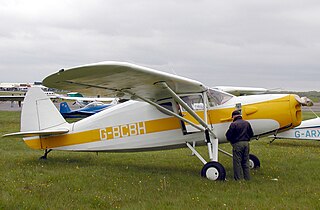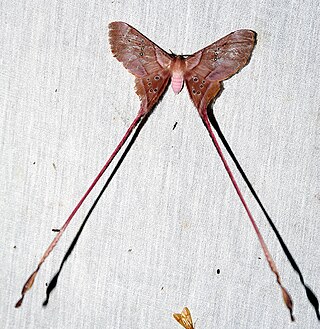
Moths are a group of insects that includes all members of the order Lepidoptera that are not butterflies. They were previously classified as suborder Heterocera, but the group is paraphyletic with respect to butterflies and neither subordinate taxon is used in modern classifications. Moths make up the vast majority of the order. There are approximately 160,000 species of moth, many of which have yet to be described. Most species of moth are nocturnal, although there are also crepuscular and diurnal species.

The Sphingidae are a family of moths commonly called sphinx moths, also colloquially known as hawk moths, with many of their caterpillars known as "hornworms"; it includes about 1,450 species. It is best represented in the tropics, but species are found in every region. They are moderate to large in size and are distinguished among moths for their agile and sustained flying ability, similar enough to that of hummingbirds as to be reliably mistaken for them. Their narrow wings and streamlined abdomens are adaptations for rapid flight. The family was named by French zoologist Pierre André Latreille in 1802.

A heath is a shrubland habitat found mainly on free-draining infertile, acidic soils and characterised by open, low-growing woody vegetation. Moorland is generally related to high-ground heaths with—especially in Great Britain—a cooler and damper climate.

Lycaenidae is the second-largest family of butterflies, with over 6,000 species worldwide, whose members are also called gossamer-winged butterflies. They constitute about 30% of the known butterfly species.
Argus is the Latinized form of the Ancient Greek word Argos. It may refer to:

The Fairchild Model 24, also called the Fairchild Model 24 Argus and UC-61 Forwarder, is a four-seat, single-engine monoplane light transport aircraft designed by the Fairchild Aviation Corporation in the 1930s. It was adopted by the United States Army Air Corps as UC-61 and also by the Royal Air Force. The Model 24 was itself a development of previous Fairchild models and became a successful civil and military utility aircraft.

The Scotch argus is a butterfly of the family Nymphalidae. In spite of its English name argus, it is not a close relation of the brown argus nor the northern brown argus.
Moon moth is a general term describing imagos of several Saturniinae species, having as a distinctive trait large round or near-round spots on the forewings and hindwings - hence "moon".

The Cape Town Cycle Tour, formerly known as the Cape Argus Cycle Tour, is an annual cycle race hosted in Cape Town, South Africa, usually 109 km (68 mi) long. It is the first event outside Europe to be included in the Union Cycliste Internationale's Golden Bike Series. South Africa hosts some of the largest, by the number of entrants, sporting events in the world with three being the largest of their type. The Cape Town Cycle Tour, with as many as 35 000 cyclists taking part, is the world's largest individually timed cycle race. The other two are the world's largest ultra-marathon running event, the Comrades Marathon, and the world's largest open water swim, the Midmar Mile.

The Cape Argus is a daily newspaper co-founded in 1857 by Saul Solomon and published by Sekunjalo in Cape Town, South Africa. It is commonly referred to as The Argus.

Actias is a genus of Saturniid moths, which contains the Asian-American moon moths. Long tails on their hindwings are among their distinctive traits. Other moths with similar appearance are Copiopteryx, Argema and Eudaemonia.

The Saturniinae or saturniines are a subfamily of the family Saturniidae, also known as giant silkmoths. They are commonly known as emperor moths or wild silk moths. They are easily spotted by the eyespots on the upper surface of their wings. Some exhibit realistic eye-like markings, whilst others have adapted the eyespots to form crescent moon or angular shapes or have lost their wing scales to create transparent windows. They are medium to very large moths, with adult wingspans ranging from 7.5 to 15 cm, in some cases even more. They consist of some of the largest sized Lepidoptera, such as the luna moth, atlas moth, and many more. The Saturniinae is an important source of wild silk and human food in many different cultures.

Argina is a genus of tiger moths in the family Erebidae. They are distributed throughout Africa, Mauritius, China, India, Sri Lanka, Myanmar, Andaman Islands, New Guinea and Australia.

Plebejus argyrognomon, common name Reverdin's blue is a butterfly of the family Lycaenidae. The species is named after Jacques-Louis Reverdin.

Argina astrea, the crotalaria podborer, is a moth of the family Erebidae. The species was first described by Dru Drury in 1773. It is found in eastern Africa, southern Asia of India, Sri Lanka, Maldives and Indo-Australia, including the Pacific Islands and Australia.

Eudaemonia is a genus of moths in the family Saturniidae. They are native to Sub-Saharan Africa and have remarkable, extremely elongated "tails" on the hindwings.
Eudaemonia argiphontes is a species of moth in the family Saturniidae. It is found in Africa, including the Central African Republic, Gabon, Guinea and Equatorial Guinea.
Eudaemon was an ancient city in Arabia, modern day Aden.

770 Naval Air Squadron was a Naval Air Squadron of the Royal Navy's Fleet Air Arm. It last disbanded at HMS Nighthawk, RNAS Drem in October 1945. 770 Naval Air Squadron initially formed as a Deck Landing Training Squadron at HMS Daedalus, RNAS Lee-on-Solent, in November 1939. Embarked in HMS Argus, and operated from the aircraft carrier and Hyeres la Palyvestre in the south of France, until it disbanded in May 1940. It reformed at HMS Merlin, RNAS Donibristle, on New Year’s Day 1941, as a Fleet Requirements Unit out of 771 Naval Air Squadron’s 'X' Flight. It moved to HMS Jackdaw, RNAS Crail, in June 1941, then two and half years later it moved to HMS Jackdaw II, RNAS Dunino in January 1944, before finally moving to HMS Nighthawk in July.
St. Louis Argus is an African-American-oriented weekly newspaper founded in 1912 by brothers Joseph Everett Mitchell and William Mitchell. It began as a newsletter for an insurance company named Western Union Relief Association. The Argus is the oldest continuous black business in St. Louis, Missouri.















